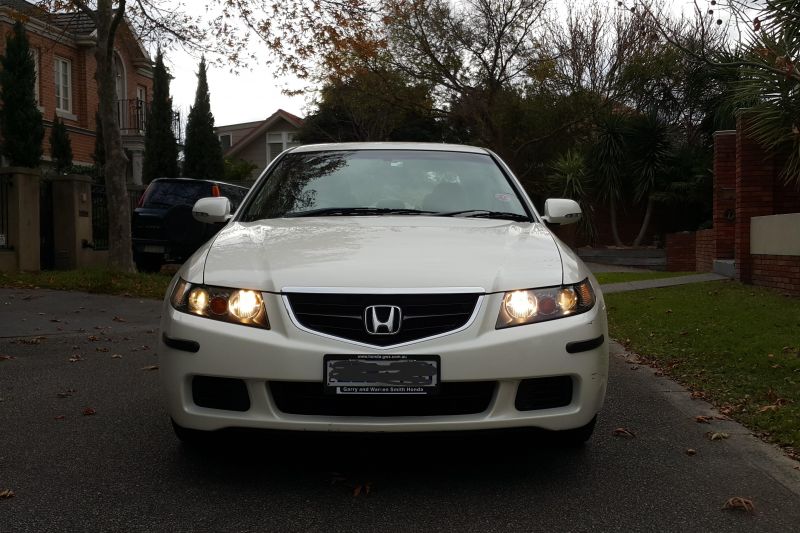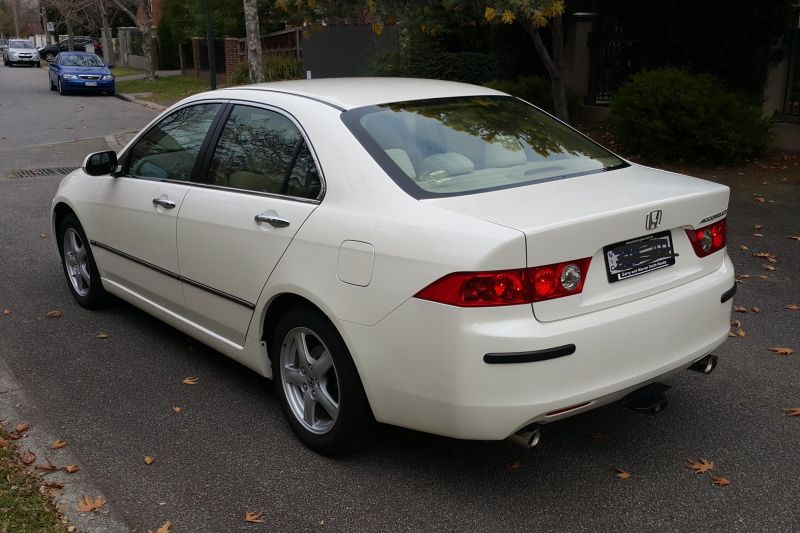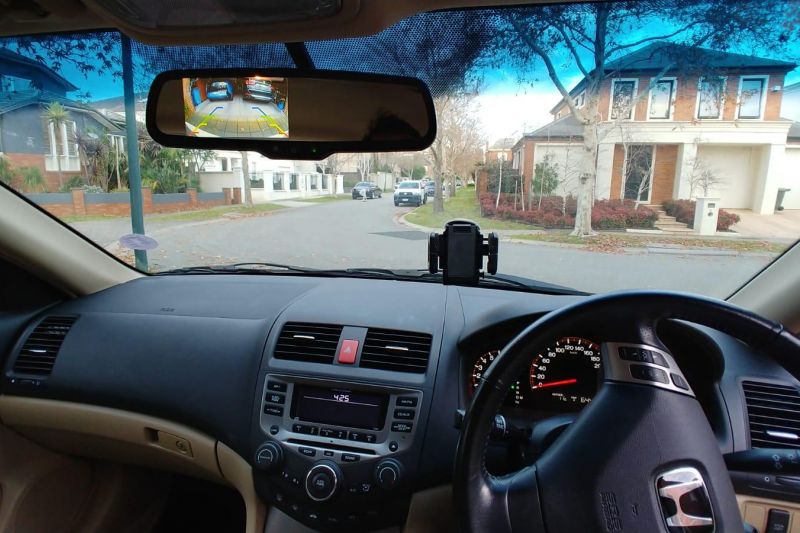About the Honda Accord Euro
Tim S purchased this Honda Accord Euro used for $7,500 (including all on-road costs) in 2020. Tim S would buy this car again because: “Owning this car, albeit for only a short time, was a very special experience for me.
Let’s go back in time for a moment: My grandparents bought the pearlescent white 7th generation Accord Euro new in 2004. Prior to that, Nanna had an LD Astra hatch, and their second car was a first-generation Discovery TDi. They were looking for something more comfortable, safer and generally easier to live with. I remember they cross-shopped with the XV30 Camry, and in hindsight I think they made the right choice.
I was seven when they bought the Accord Euro. At that time, Nanna used to cart my brother and I around when we’d go on outings or when we stayed with her during school holidays. Since then, Ive finished primary school, completed VCE, graduated from uni and started working full-time; my point is that a lot has changed since my grandparents took possession of the vehicle, yet that car remained a fixture of our family life.
In early 2020, I was 22 and between cars. I hadn’t been driving much so I could always borrow one of my parents’ cars (or my then-partner’s car if I was desperate), but I started having to regularly drive a few times a week so began thinking about having my own wheels again.
My dear Nanna was around 88 years old at that time, so naturally my family and I saw this as a good opportunity to gently relegate her to passenger-only duties while keeping the old Honda within the family.
In February 2020 I took ownership of the car for $7500. It had 50,000-odd kilometres on the clock, and I added less than 10,000km to that when I had it. The cream fabric interior would not have been my pick from a practicality point-of-view, however the bright interior was a nice place to be (certainly more aesthetic then the ugly dark grey fabric option).
From the outside, I think the car aged very well, with simple, elegant lines and attractive lights.
Having made some upgrades during my ownership, I ended up selling the Accord Euro in December 2020 for $11,400 to a very excited L plater. While I was ready for an upgrade, I was rather sad to part with that car which had been in the family for over 16 years.”
How reliable has your car been? Tell us about any issues.
For me, the car was totally reliable and ran without fault. My grandmother generally serviced it on schedule for the most part – not really an issue given the gentle few miles she put on it. It was always serviced at a Honda service centre. The only issue I encountered was a slightly sticky lock on the front-passenger door, occasionally requiring a second press of the key.
I remember that at some time during my grandmother’s ownership, one of the ignition coils failed. Fortunately the car wasn’t left to limp on three cylinders for long as it was promptly booked in for a service to remediate the issue.
When I took the car in for a service not long after I bought it, the mechanic rang me and reported that there was carbon build-up. I think it was a few hundred dollars extra for the job, so ultimately decided to leave that for the next owner to deal with!
What do you think of the ownership experience with your car?
I have no complaints with regard to the ownership experience of the Accord Euro. The service intervals seemed to be reasonable to me and the services were reasonably-priced. I would have preferred if the car was slightly more economical and could run on standard unleaded (91), but overall it was a car that I enjoyed owning and driving.
A lot can be said about the convenience of owning a car that has a few bumps and scratches. The car had acquired some APD (Accumulated Parking Damage) despite Nanna’s careful hands and keen eyes, but this meant that I could park in supermarket and shopping centre carparks without too much worry if it got doored or attacked by a runaway trolley.
The thing I liked most about the Accord Euro was the build quality. Every part of the interior and exterior was engineered and assembled beautifully, with tight, consistent gaps, high quality materials, and no rattles.
Things like the quality seals, the feel of the stalks, buttons and switches and the way the doors opened and closed were representative of Japanese quality and, in my opinion, positioned the Accord Euro as a true 3 Series competitor at the time it was built.
Are you happy with the price and features of your car?
Given the price I paid for the car, the features stack up pretty well.
This base model example came with projector headlamps, power windows with auto driver’s window, power mirrors with LED indicators, dual-zone digital climate control, speed-sensitive wipers, leather gear lever and steering wheel, dual exhausts with chrome tips, courtesy lamps in the front doors, lamps in the vanity mirrors, glovebox and ashtray, and illuminated steering wheel controls for the radio and cruise control.
Having a boot release button on the key was a handy feature, while the windows could be opened remotely to ventilate the car by holding the key’s unlock button.
At the time of purchase, the car was optioned with cream carpet floor mats, protective black plastic strips on the bumpers and doors, and a flat tongue-style towbar which was a necessary feature for me. As someone who had been accustomed to the practicality of hatches and SUVs, moving to a sedan was a bit of an adjustment, however being able to fold the rear seats down did come in handy.
The Accord Euro had good safety credentials, with ABS, traction control and ESP equipped as standard. Unfortunately it only had curtain airbags for the driver and front passenger, so I used to avoid having people in the rear seats whenever possible.
During my ownership, I made some minor modifications with my dad’s help. We modified the wiring of the interior lights so that the front dome lights would come on when the doors were opened (previously only the rear dome light came on).
We also installed a metallic tape-style hidden reversing sensor, and a reversing camera which displayed on a replacement rear-view mirror, which also added auto-dimming functionality. The addition of the sensors and camera were a huge value-add for me given my reliance on those features to park safely and accurately.
What do you think of the performance and economy of your car?
For the most part, the drivetrain of the Accord Euro was a ripper. It had a 2.4-litre naturally aspirated four cylinder i-VTEC engine producing 140kW and 223Nm, which for the time was impressive.
The engine had a typical rev-happy Honda personality and engine note, as well as a strict diet of premium unleaded – another typical Honda trait. Pre-facelift Accord Euros like mine had a mechanical throttle, despite the competition from Toyota and Mazda using drive-by-wire throttles by that time.
This feature would be introduced in 2006 along with a multifunction trip computer and other minor changes.
The car I had was equipped with an electronically controlled five speed automatic transmission. Like most of the automatic transmissions used in Honda vehicles, the ‘H5’ was designed and built in-house and used clutch packs rather than planetary gear sets.
In this way, it is mechanically similar to a manual transmission. It was a smooth-shifting unit and did the job perfectly well, however the car did creep very aggressively when on choke which could be a bit disconcerting when navigating low-speed manoeuvres.
According to the claimed figures, the Accord Euro could launch itself to 100 km/h in less than eight seconds, which is pretty sprightly. It certainly had more than enough power to make the traction control light flash when taking off from the lights in the wet.
In typical driving situations, the transmission would shift fairly early, which was great for economy and refinement, but did dull the performance a little. Likewise, the gears had a wide spread, with the transmission shifting into fifth around 70 km/h.
Compensating for this was possible, but a bit too much sauce on the throttle could result in a double downshift and create a lot more noise and fuss than desired.
Flicking the chunky leather gear lever towards the right from Drive into manual mode would illuminate another seven-segment display on the instrument cluster to display the current gear. Razor-quick gear changes were not to be expected, but the manual mode offered a bit more engagement and control when in the mood. The transmission also had a D3 option which I had no use for.
Given that the trip computer didn’t have a fuel consumption readout, I naturally didn’t pay much attention to the economy figures. Based on manual calcs at the pump, the car used around 10L/100km around town, which dropped to around 8L/100km on the open road (e.g. when driving to Bendigo).
Slightly better economy would have been nice, but it didn’t concern me for the minimal amount of driving I did.
What do you think of the technology in your car?
Given the vintage of the car, there isn’t much technology to speak of, but the execution of the tech that was present was generally excellent. Standard on the Accord Euro was an AM/FM radio with a six-disc CD changer, which until my ownership was almost exclusively tuned into talkback AM radio.
To help make the infotainment more millennial-friendly, I purchased a Bluetooth-FM transmitter and a suction cup phone holder.
The transmitter was an excellent purchase and worked really well. The position of the 12V power outlet meant that the unit was within reach and I could use the buttons to skip and pause music and accept calls.
It also had a 2-amp USB port which as handy to charge my phone, which I had mounted to the left of the instrument cluster. I ran Android Auto on my phone for Maps, Spotify and Google Assistant.
The audio quality through the FM transmitter was pretty good. The head unit was powerful and the six-speaker system was impressive, with the oval-shaped parcel shelf-mounted speakers producing plenty of deep bass. The LCD radio display with graphical volume level was a bit gaudy by today’s standards, but the way that the volume gradually increased when the radio turned on was a nice touch.
If I was super passionate, I could have bought and installed a Bluetooth module that uses the external CD changer interface which would allow me to skip tracks using the steering wheel controls, but I couldn’t justify the significantly higher cost.
The other main piece of technology in that car was the instrument cluster. It was the first Accord to use LED backlighting, and the way that the large dials smoothly faded into view was very classy.
The design of Honda instrument clusters have barely changed since, because they’re clean, contemporary and very easy to read. Functionality was very limited, however, with the display only able to cycle through the odometer, Trip A, Trip B and the external temperature.
What do you think of the ride comfort and handling of your car?
The Accord Euro was generally a pretty comfortable place to be in, however the ride was pretty firm. Along with the suspension tune, the small-diameter wheels and low-profile tyres also didn’t help with the ride quality.
The benefit of the firmness, however, is that the car stayed very flat around the bendy bits. The steering was very heavy by today’s standards – almost frustratingly so – but that did give the Honda a sporty, solid feel.
One of the main quirks with that car was the way the steering behaved on uneven surfaces.
In particular, accelerating and braking at lights where grooves have formed in the road could make the steering pull quite dramatically – an effect I’ve experienced in other front-wheel drive vehicles, but not to that extent. I hope that this is something that Honda was able to iron out in subsequent models.






